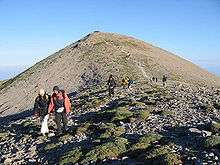Mount Ida (Crete)
| Mount Ida | |
|---|---|
| Psiloritis (Timios Stavros) | |
.jpg) View of Psiloritis mountains from west | |
| Highest point | |
| Elevation | 2,456 m (8,058 ft) [1] |
| Prominence | 2,456 m (8,058 ft) [2] |
| Listing | Ultra |
| Coordinates | 35°13′36″N 24°46′21″E / 35.22667°N 24.77250°ECoordinates: 35°13′36″N 24°46′21″E / 35.22667°N 24.77250°E [2] |
| Geography | |
 Mount Ida Location in Greece | |
| Location | Crete, Greece |
Mount Ida, known variously as Idha, Ídhi, Idi, Ita and now Psiloritis (Greek: Ψηλορείτης, "high mountain"), at a height of 2,456 m (8,057 feet), is the highest mountain on Crete. Located in the Rethymno regional unit, it was sacred to the Greek Titaness Rhea, and on its slopes lies one of the caves, Idaion Andron, in which, according to legend, Zeus was born. Its summit (Timios Stavros)[1] has the highest topographic prominence in Greece.[2][3] A natural park which includes Mt. Ida is a member of UNESCO's Global Geoparks Network.
Features
The Skinakas observatory of the University of Crete is located on the secondary peak Skinakas at 1750 m. It has two telescopes including a 1.3 m Modified Ritchey-Chrétien instrument.[4][5]
Mount Ida is the locus for a race of legendary ancient metal workers (Dactyls), whose roots are also associated with Cyprus.[6]
The Nida plateau is found to the east of the mountain.[7]
On the summit of Ida is the little chapel of the Holy Cross, Timios Stavros.[8]
On the plateau are some shepherd's huts (mitata) built only of local stones, and used both for shelter and for cheesemaking.[9][10][11]
Idaean Cave
In ancient times the Idaean cave, "cave of the Goddess" (Dea) was venerated by Minoans and Hellenes alike. By Greek times the cave was rededicated to Zeus.[12] The cave where Zeus was nurtured is variously stated to be this cave, or another of the same name, or the Dictaean cave.[13]
Votive seals and ivories have been found in the cave.[14] Like the Dictaean cave, the Idaean cave was known as a place of initiations.[15] It may have served as the site of an oracle, symbolized by the frequent depiction of a tripod on coins of nearby Axos, which presumably controlled the territory around the cave.[16]
Mythological origin of the Jews in classical antiquity
In his Histories,[17] the Ancient Roman historian Tacitus reported a belief, popular in antiquity, regarding Mount Ida and the origin of the Jews, complete with conjectural etymology:
- "It is said that the Jews were originally exiles from the island of Crete who settled in the farthest parts of Libya at the time when Saturn had been deposed and expelled by Jove. An argument in favour of this is derived from the name: there is a famous mountain in Crete called Ida, and hence the inhabitants were called the Idaei, which was later lengthened into the barbarous form Iudaei."(Book V:2)
Gallery
 Mouth of the Idaean Cave
Mouth of the Idaean Cave East ridge of Mt Ida, Psiloritis in Modern Greek
East ridge of Mt Ida, Psiloritis in Modern Greek Shepherd's hut (mitato) on Nida Plateau, eastern side of Mt Ida
Shepherd's hut (mitato) on Nida Plateau, eastern side of Mt Ida
See also
- 243 Ida, an asteroid named after the mountain
- Mount Ida, known as the Phrygian Ida in classical antiquity
- Mount Kedros
References
- 1 2 "Mount Ida, Greece". Peakbagger.com. Retrieved 2 May 2015.
- 1 2 3 "Europe Ultra-Prominences". Peakbagger.org. Retrieved 2 May 2015.
- ↑ Topo25 Hiking Map of Mt IDHA (2006 edition)
- ↑ "Skinakas Observatory". University of Crete Department of Physics. Retrieved 15 March 2015.
- ↑ "Skinakas Observatory". Skinakas Observatory. Retrieved 15 March 2015.
- ↑ Pliny (translated by Mary Beagon). 2005. The Elder Pliny on the Human Animal: Natural History, Book 7, Oxford University Press, ISBN 978-0-19-815065-7, 515 pages
- ↑ "Introducing Mt Psiloritis". Lonely Planet. Retrieved 15 March 2015.
- ↑ "Eastern Crete Mountains". A Crete Guide. Retrieved 25 August 2015.
- ↑ Antonis Plymakis, Koúmoi-Mitáta kai Boskoi sta Leuká Ori kai Psiloriti ("Shepherd's huts and shepherds in the Lefka Ori and the Psiloritis"), Chania, 2008, 630 p.
- ↑ Harriet Blitzer, Pastoral Life in the Mountains of Crete. An Ethnoarchaelogical Perspective, in Expedition, vol. 32, No 3, 1990, pp. 34-41 (on the shepherd's huts of Eastern Crete.
- ↑ Sabine Ivanovas, Where Zeus Became a Man (with Cretan Shepherds), Efsthiadis Group Editions, 2000, 183 p. (Life in the corbelled dry stone huts of central Crete).
- ↑ Diodorus Siculus, V.70.
- ↑ William Smith, ed. (c. 1873). A Dictionary of Greek and Roman biography and mythology. John Murray.
- ↑ J. Lesley Fitton,Ivory in Greece and the Eastern Mediterranean from the Bronze Age to the Hellenistic Period (British Museum. Dept. of Greek and Roman Antiquities),1992
- ↑ Yulia Ustinova, Caves and the Ancient Greek Mind: descending underground in the search for Ultimate Truth 2009:180.
- ↑ Ustinova, noting Capdeville 1990, and, critically, Prent 2005:568.
- ↑ http://penelope.uchicago.edu/Thayer/E/Roman/Texts/Tacitus/Histories/5A*.html
| Wikimedia Commons has media related to Mount Ida (Crete). |